Kurapia
Does anyone have experience with this groundcover? A local nursery is suggesting it in place of backyard lawn in a small area. Thanks!
Comments (63)
caralann
5 years agoThanks. I found a pre-emergent herbicide that might help - Prodiamine (Barricade).
https://turfgrass.ucr.edu/reports/water_conservation/kurapia_2016.pdf
BlueSky Susan (10b-24)
5 years agoSorry to resurrect an old-ish thread . . . where can I see some established Kurapia in Southern California? I'm near LAX. Anybody know of any public installations, or front yard lawns I could (diplomatically) walk by? Thanks!
Related Professionals
Stoughton Landscape Contractors · Ashburn Landscape Contractors · Euclid Landscape Contractors · Lewisville Landscape Contractors · Longmont Landscape Contractors · Merced Landscape Contractors · Middleton Landscape Contractors · New Berlin Landscape Contractors · Plainview Landscape Contractors · New Carrollton Landscape Contractors · Missouri City Swimming Pool Builders · Safety Harbor Window Contractors · Glendale Heights Window Contractors · Marshfield Window Contractors · Piedmont Window ContractorsScott Carter
4 years agoWe tried Kurapia on a small shaded yard in the Oakland area. It worked well for a year, then in the rainy winter last year it died out from what looks like a combination of fungus and weeds crowding it out. Before that, it was pretty reasonable looking and lived up to the low maintenance claims. In our yard, the sunniest part (not quite full sun) did the best. I might try it again, but for our tiny space may go back to grass.
lgteacher
4 years agoIf you are in or near Orange County, you can see it here: http://screc.ucanr.edu/
Open House Sept. 28, 9 - 2. Free! Classes on low water use landscaping.
emmarrie
4 years agoHere's the status on our 2-year-old kurapia front yard: Last week the termite guys stomped repeatedly all over it as they were setting up the tarp for tenting. This coincided with high heat plus browning flower stalks, so many areas do look quite trampled down! So, this week we plan to give our 4-to-10-inch-high kurapia a haircut with the wire trimmer. Stay tuned for the results. :O
HU-353278136
4 years agolast modified: 4 years agoPlanted kurapia plugs and it took a year for it to fully cover due to very poor soil that I neglected to improve prior to planting. Soon after my lawn was fully covered in nice dark green kurapia with flowers everywhere parts of my lawn turned light green to yellowish and lost their flowers. Then the leaves started drying up. Now I have bald spots and it is spreading. Any idea what the problem is and how to fix it? The website I bought the plugs from recommends a particular fungus treatment but not sure we have a fungus issue.
emmarrie
4 years agoHU-353278136 - If you are watering more than once weekly, you may have a fungus issue. Kurapia hates over-watering. The times we have over-watered we've gotten mushrooms.
emmarrie
4 years agoWe're a bit warmer than L.A. and water just once weekly in the summer - all is fine as long as the sprinklers are not blocked with calcium deposits. Are you in the desert? That's where 100 degree temps are. Kurapia really does just fine in L.A. and Orange County with weekly watering in the summer and monthly watering in the winter if there's very little rain. A rainy winter would mean no watering whatsoever in the winter. Kurapia truly does hate over-watering! Too much will kill it, no joke.
HU-353278136
4 years agolast modified: 4 years agoMaybe because of the nutrient poor soil that drains too well our Kurapia behaves differently. Kurapia that is in the shade is doing great. We recently planted a tree in the middle of the lawn I have been placing tree watering bag around the tree and the kurapia there is growing like wild fire. Also i had kept clippings of kurapia standing only in water over a month and it loved it. Grew a bunch sprouted flowers etc.
Rich Geiger
4 years agoWe are in Scottsdale Arizona and planted Kurapia 3 weeks ago on November 19. We have been watering three times a day for 20 minutes per session. Unfortunately, it has also been rainy, cold and very little sun. Well, our Kurapia dying a slow death and we do not know what to do. We are afraid of fungus or root rot if we keep watering so heavily. The top side is mostly all brown and there are very few root sprigs if you pull up a piece of turf. Any advise would be greatly appreciated, as we fear we may have planted at the wrong time of year. Thank you for any help. All best, Rich
BlueSky Susan (10b-24)
4 years agoThat's a LOT of water! Not sure what kind of sprinklers you're using, but mine got like 5 minutes once a day for a few months, and now they get 3 minutes every other day.
lgteacher
4 years agoSpring is probably a better time to plant, but if I were you, I'd reduce the water, especially if it's been rainy. http://kurapiaplugs.com/wp-content/uploads/2014/12/Kurapia-Installation-and-Care-Guidelines-for-the-Homeowner.pdf
HU-115240009
4 years agolast modified: 4 years agoHas anyone used it outside of CA/AZ/NV... we are in Kansas, we are in zone 7 but not sure how this ground cover will do with more rain and long winters.
BlueSky Susan (10b-24)
4 years agoUpdating to add photos of my Kurapia. It was installed in May 2019, from plugs, New White variety from Kurapia Direct, so it is 10 months old in these pictures. I am in 10b/24 area, coastal LAX/Westchester area. Quite a lot of cloud cover and cool. The yard faces south west, so the Kurapia gets full sun most of the day, other than the left side of the picture which gets some afternoon shade and the extension up by the toyons, which gets at least half day shade. The tree in the middle is a Jacaranda that produces some shifting light shade. My soil type is on the sandy end of pure sand. We amended it a bit before installing the plugs.
I had overhead sprinklers installed for it. Overall I am very happy with it. The only maintenance I do is the gardener does edge trimming every few weeks. It tends to grow tendrils as it is spreading, and I've started snipping those off in areas where it has sufficiently filled in. I don't *expect* there will be a huge amount of tendril snipping in my future, but you never know!
There are definitely "better" and "worse" areas. The Worst area is a little bit of a high spot, so it could be getting less water, or the soil could be worse there, I'm not sure.
Weeds were a bit of a pain at the beginning, but the Kurapia is dense enough that new weed sproutage is way down now that it has pretty much filled in, especially through the winter months.
It definitely gets a LOT of flowers. They look pretty, until they die, then they sit there ugly and brown until you whack them off.
I have not mowed.
Overview: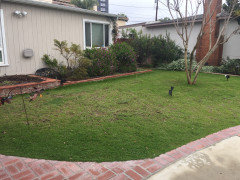
Overview, other direction: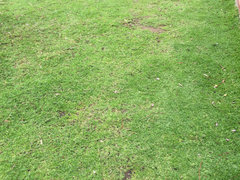
Closeup of best area: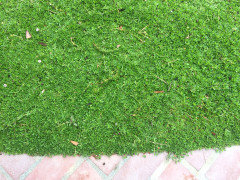
Closeup of worst area: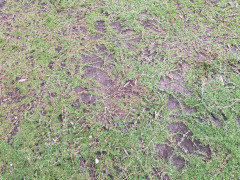
Area that gets afternoon shade: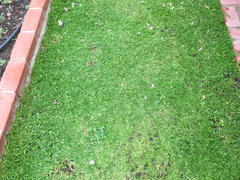
So far, other than the strings trying to invade my neighbor's yard, I haven't noticed too many Kurapia volunteers around the yard, but there have been a couple. It's not totally sterile.BlueSky Susan (10b-24)
4 years agoWeird, Houzz is cropping vertical photos to make them horizontal in the previews.
Gregory Thomson
4 years agoAny of you that have Kurapia have gophers? I never had gophers before, but now I have one making its way through my Kurapia. I did my plugs at 14-16" distance I think. And now that I think about it, that might be a nice environment for a gopher because the Kurapia has deep tap roots then with nice space in between for a gopher to route around the tap roots. Looking for ways to encourage it to go elsewhere, but that's probably not relevant to this post unless you have had to deal with it also.
BlueSky Susan (10b-24)
4 years agoI might, not sure. I'm starting to have very small piles of dirt (like 1" x 1/2") appearing all over my lawn. No holes but . . . I have no experience with gophers.
Gregory Thomson
4 years agoWorms are good right? They are usually beneficial in what they do - aerating the soil, worm poop, etc... Hopefully mine aren't worms - the piles are more like a foot across. That would be some really big worms! :-)
rules1138
4 years agoDoes anyone have any recommendations on a good herbicide (pre and post) to kill oaxalis(Yellow Woodsorrel) and crabgrass?
Gregory Thomson
3 years agoI think my experiment with Kurapia may be over at this point. Gave it two years to establish, and then I didn't water much this past summer in SoCal, thinking it was far enough along to be okay. It seems mostly dead now. Not sure if it will come back in Spring 2021, but will wait and see. I think if I stayed on top if it, it probably would have done better. But with a pooch back there I wasn't liking all the flowers attracting bees. I know it can be mowed to avoid that. But I'm just not feeling it's a good match for me. Will see what it does come Spring 2021. But I may be looking to go a different route that seems like it may be a better match, or at least another experiment to try out next - https://cjgardeningcenter.com/products/greenwave?variant=19767143497828
BlueSky Susan (10b-24)
3 years agoHow's it doing now Greg? Mine's looking very nice. It got a little yellowish over the winter, but I noticed the patch under the bird feeder (hidden to the left) thriving (like, going gonzo). Figure it's the bird poop. So I went to the big orange store and got some bags of chicken poop and sprinkled that around, and sure enough, instant green. My poor sandy soil was amended when the Kurapia was planted, but may have needed a touch up. So now I think I'll do that once or twice a year when it starts looking poorly. For references this is almost exactly two years from planting. I live near LAX where we get a lot of summer fog. Sprinkler is for tree, ignore. Kurapia is on overhead RVAN45 sprinklers, a few minutes every third day currently. I think 8 minutes.
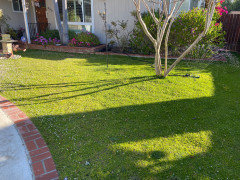
Gregory Thomson
3 years agoMine's not doing so well. But I do still have hope for it. I neglected the yard the past year - just too many other things going on. But I'm hoping to semi-retire in the next 2 or 3 months, so then I'll be able to start getting things back in shape better. I have about the same size with it, and four big patches got well established with it. So I'm going to focus on those a bit. Seems like they will spread in to fill in the middle with more time. Gophers also have been digging things up, but no more signs of them the past couple months. In the four patches where it has gotten established, it definitely crowds out the weeds from growing there. But it also needs some TLC soon to get it going better and spreading into the remaining spaces.
Lawrence Ziese
2 years agolast modified: 2 years agoHello everyone, these are some good discussions. I'm the head researcher and manager of Kurapia here in the United States and thought I could answer a few questions. First, it's related to Lippia repens that was referred to by a few people is not the same as Kurapia. Kurapia's botanical name is Phyla nodiflora 'Kurapia New White'. They are very different. Kurapia is sterile, so it doesn't produce seeds that spread to areas you don't want it. It also stays green over the winter in USDA zones 7B and above. It does produce roots that can get up 12' and longer, which is why it's so incredibly drought tolerant. If you'd like to learn more check out our new support page at www.kurapia.com/support and learn more!.
Gregory Thomson
2 years agoThank you Lawrence, I was just about to ask you how to feed it, but went to that page instead, and there it was.
I do have a question, though...
I used an auger on a drill to create the holes for the plugs. All seemed good, but over a bit of time, that hole where the plug was put wasn't as solid as the surrounding area, so it created a divot/dimple where they are.
I'm semi-retiring in a month, so will be back a bit more to working in the yard soon.
Is there a best/recommended way to go about leveling it better at this point like with mason sand, or some other mixture?
Seems like people use that for blade grass. I'm not sure how well it would work with Kurapia.
And it sounds like once they start doing it, they have to keep doing it over time to keep it level.
Is there a better way to get it back to more level a couple years in?
Also, I have one section that has grown really thick/high beyond the rest. I'm guessing about 2" high. If I cut that down considerably to maybe 3/4" high, after about 3 years planted now, has it gotten established well enough that it will handle that okay?I'm in SoCal, and have barely watered it in the past year, so it seems like the roots in that area must be pretty deep for it to have grown so well in that area even without watering?
So if the roots are deep, does that make it easier for it to survive a bigger scalping on the top side?
Lawrence Ziese
2 years agolast modified: 2 years agoWow, you have a black belt in question asking, well done!
"I used an auger on a drill to create the holes for the plugs. All seemed good, but over a bit of time, that hole where the plug was put wasn't as solid as the surrounding area, so it created a divot/dimple where they are."
Augers are cool because they loosen up that hole on the sides and below, giving the roots places to grow quickly. A little divot is ok, as over time the soil will level itself with airborne and water carried soil movement. The kurapia stems all root into soil it touches so it will be great planted a bit deeper than the soil around it.
"I'm semi-retiring in a month, so will be back a bit more to working in the yard soon."
Happy Retirement!
"Is there a best/recommended way to go about leveling it better at this point like with mason sand, or some other mixture?"
That depends on your soil. The key is to get the soil closer to loam, so for heavy clay, I use masonry or playground sand (washed and inexpensive), and for heavy sandy soil I incorporate compost that's been fully rotted, such as seed starting soil mixes to ensure there's a good amount of organic material to help retain water as the plugs fill in.
"Seems like people use that for blade grass. I'm not sure how well it would work with Kurapia.
And it sounds like once they start doing it, they have to keep doing it over time to keep it level.
Is there a better way to get it back to more level a couple years in?"
That's kind of depends on a lot of site specific factors, how water runs through the area, the slope and angle of the soil, clay pockets and aquifer distance from below, the level of the bedrock.. Sand is great but keeping soil level requires knowing what's going on below.
"Also, I have one section that has grown really thick/high beyond the rest. I'm guessing about 2" high. If I cut that down considerably to maybe 3/4" high, after about 3 years planted now, has it gotten established well enough that it will handle that okay?"
Mowing Kurapia is always a good thing. I recommend once a month, twice a month if you don't want flowers or have annual weed issues. Mowing also helps keep the kurapia from growing horizontal shoots which helps the spread rate over time.
"I'm in SoCal, and have barely watered it in the past year, so it seems like the roots in that area must be pretty deep for it to have grown so well in that area even without watering?
So if the roots are deep, does that make it easier for it to survive a bigger scalping on the top side?"
Kurapia roots are DEEP, sometimes they grow over 10' tall if you're drought training your plants, and they can be quite thick. New growth can generate from the stems of the plant, and if you have green stems on top of the soil they will more than likely sprout so long as there's a meristem. However, don't scalp so deeply that you're cutting into the root layer, as that's below the meristem which will cause the roots to die off if they can't resprout. Best to test a small area first before going whole hog on the whole area.
Gregory Thomson
2 years agoHi Lawrence,
What are 'clay pockets'? Intermittent areas that are more clay-based than sandy, but in an area that may otherwise be mostly sandy?BlueSky Susan (10b-24)
2 years agoJust writing an update to note that as of end of year 2021 (2.5 years in), my Kurapia is still doing well. It looks the same as the last round of pictures. Weeds and invading grass from Neighbor's lawn are more of an issue now, so I have it mowed every couple of weeks rather than trying to pull the weeds. Mowing off the flowers really improved the looks this summer too. The flowers are fine when they're white (quite cute in fact) but they turn brown and stay on the plant, and that looks ugly when there are so many of them.
hsuanhuey
last yearlast modified: last yearI have my Kurapia 'pink' installed for almost two years. About 60% of the lawn are doing very well. However, part of the Kurapia is invading by Fourleaf allseed (Polycarpon tetraphyllum), and part of the lawn is becoming a gopher's playground. Does anyone have similar problems? Any suggestions?
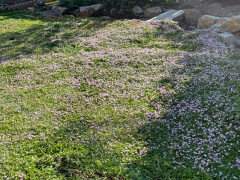
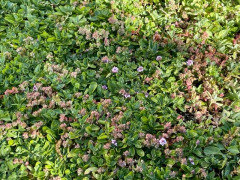
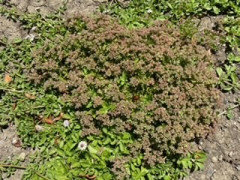
Aaron Capan
last yearMine gets invaded by the fourleaf clovers and other weeds I’ve read that I should only be watering the Kurapia like once a month, and it needs to be trained to survive this way. If I/we do this, no weed will survive. Only the kurapia will. I’ve only gotten to the point where I am watering once weekly (as infrequently as I ever have… in a hot climate) and ive seen the clovers and other weeds die quick.
That doesnt change the fact that you have to pull the weeds. Also, it doesn’t change the fact that in the winter, when it rains, the weeds will come back.
If someone else has a solution, and has found a chemical that will kill all the weeds and not the kurapia, I’m all ears! that would change my life.
Good luck!john nazareno
last yearlast modified: last year1st thing to do to have a successful Kurapia grass is to amend soil with compost (rent a tiller with HD or lowes) till it 12 inches with 1.5-2 cubic yard 300-350 sq ft, then water 1st week 3x day (enough to wet roots zone but not drowned it, then once every other day for a week or two then 1x week rest of year (deeply), second yr, it should be established deeply and perhaps try watering it once a month .. but if starts looking sad water some more or if it grows faster than you want, water less, I only water about 1 gallon or less per sq foot a month this days or just the area that dog pee kills to make it grow faster..even when it's almost dead, some water will bring it back (from experience forgetting to water it when it was young and barely rooted) it's been 3 yrs and looking good with hardly any water (Kurapia does store lots of water in it's leaves, you can feel it's moist in the morning) and the more you step on Kurapia the lower it will grow, the less it might grow 3-6 inches tall (or with more shades) and might need mowing
For weeds and other others, they will still grow but not much (most of the weeds comes from my neighbors who doesn't weed until all the seeds has set so they get blown from their yard to mine but hardly any will grow but sort of stunted, just pull them as you see em including the roots esp the "Fourleaf allseed", you might even need to dig out the soil around that and throw it away, don't worry Kurapia grows super fast esp when it's getting lots of sun, after yr 3, hardly any weeds has come up this yr and weeds tend to grow crazy in droughts!
My dog loves to sleep in Kurapia even when it's 115 outside, it's all cool, go bare foot and try it out but I end up waking him up after a few mins since I don't want him to get dehydrated
Best time to put Kurapia is late winter/early spring when things are starting to warm up that would give the roots time to spread before it's super growth kicks in..if you have a big yard and can't spend money, I would suggest buy a tray and that would grow/cover/blanket to 300-500 sq ft the first yr, you could spread that out but to cover 1000 sq ft might take the next yrJeff Adams
10 months agoI planted new both white & new pink Kurapia plugs here TOGETHER around mid March of 2022 in Tempe, Arizona…about 1600 max sf total. Looks great ! I water more more often in warm weather & fertilize lightly occasionally; also adding minute amounts of slow release sulfur. The only place it stubbornly will not fill in yet is under a portion of a Raywood Ash tree—where there is LOTS of shade. There is a decent amount of shade under a large jacaranda tree as well…but it has filled in nicely there ! It does have a tense to grow over the edges, much like Bermuda…but is relatively easy to trim back. I love it !!
CHERYL V
9 months agolast modified: 9 months agoHelp ! planted my Kurapia in mid May ( so 3 months ago) in north OC,CA This year we had gray overcast and some rainy weather until late June. During that time the Kurapia expanded but so did the weeds. The landscaper under treated the soil before planting so the weeds and now various grasses are going nuts. I have spent days and many hours when ever I can pulling weeds while trying not to pull the Kurapia is a big challenge. Landscaper set sprinklers for 15 minutes 4 times a week. Also we have Kurapia tendrils growing in non dirt areas like onto the sidewalk but not filling in the empty areas in the soil. Also noticing some Kurapia that is yellowing and? or drying out. We have many flowers in chunks and sparse areas that have yet to fill in. Is it safe to use a weed and feed product? which one? Also can I clip the healthy threads growing across the pavement and root them in water and plant in empty spaces? Fyi our soil is a bit clay like with low sand.
john nazareno
9 months agolast modified: 9 months agoRE :CHERYL VINCENT
If you planted your plants 3 months ago, I would only water 1x weekly deeply if weather is over 90, if you have great weather say in 80's only, I would try going for 1x every 2 weeks watering deeply but also depends on your soil, if it's clay go with that schedule, if Sandy then 2x weekly and monitor, yellowing is too much water, Kurapai is one of those plants can keeps water under them so it can conserve water for drought etc. To be honest you should have water manually for 2 months and watering only the Kurapai to prevent weeds from growing. Weed products will kill the plants so you're stuck doing manual weeding for this year, it really doesn't need to be feed with anything as it will only grow faster with fertilizer
Kurapai really doesn't need a sprinkler system, more water only means faster growth but if you're lawn is already covered up, less water will slow down growth for less maintenance. I barely watered them last year and this year, perhaps an average of 10 gallons (washing my pots etc) once a month in 100+ temp
Yes this plants are easy to roots and I have giving tons of people free plants, but if you need to cover empty space that the plant has not filled in yet, just water that area so that the kurapai would grow more into that area, less on the other area that's already established
Best to kill all weeds, lawns for a few months using plastic cover ( Solarization ) before planting Kurapai for less trouble with weeds and lawns growing back, the first year just pick them manually if they do grow back, after the roots of Kurapai roots deeply, you'll have less of a problem the following year then like myself after the 3rd year or so I hardly see weeds (maybe 5x this yr I had to pull out)
FYI : If we have good rain this coming winter, then I would see if you could water the plants once monthly or two next season, monitor plants if the green shine starts to look like it's wilting then that's when to water, as long as the plant maintains its green shine I won't water (big water savings!!!)CHERYL V
9 months agoThanks for info. unfortunately we had a new drip system installed for the part of the lawn that does not have the Kurapia and the sprinklers for the Kurapia area. The landscaper set the schedule based on the new plugs and other plant needs. I need to get the manual out to figure how to change it. But we also are having a problem now with some of the Kurapia drying out and dying.
john nazareno
9 months agolast modified: 9 months agohard to kill Kurapia, only one I know is if you spray weed killer or too much fertilizer or not water deeply the first 2-3 months, water each plug manually see if that helps revive them
CHERYL V
9 months agolast modified: 9 months agoI believe besides the massive weed issue it is the watering. After reading your previous response I was out pulling weeds and grass and discovered the dirt about an inch-2 was drier than I had realized. The landscaper set the timer for often but short time. So going forward I will follow your recommendation and try water manually water for 1-2 longer periods to see if that will work.
Thanks again for your help. Unfortunately I suspect that I have lost some of the plugs.
Another question: after pulling large chunks of grass and weeds I am creating divots in the dirt under tendrils and near plug areas. How do I best support the Kurapia?
john nazareno
9 months agolast modified: 9 months agoPull out weeds daily or two, until you can control them and Kurapai roots is established (yes that means this whole year), water deep for this year (but not as much as lawn, maybe 50-60% less lawn) but always monitor after watering check how deep it went thru soil (water more as needed after checking), when its root are deeper, you will notice more and more you will need less watering, Like I said I've barely water them the last two years after winter (my summer Temp are high 90's to 118), Kurapai don't really need much support, no fertilizer, no weed killer which will kill the plant, but if you feel they are underperforming perhaps some bone meal would help with roots development. I've experimened with this plants a lot, few times some of the plugs were already brownish after no water for a while, I've water and they came back within days
CHERYL V
9 months agoAny suggestions for the many healthy tendrils that are growing across the paved areas? Can they be rooted in water and re planted?
john nazareno
9 months agoI use a trimmer, then use them as organic amendments for other trees. Trust me you'll have plenty all the time but you could also grow and give away to family and friends
CHERYL V
9 months agoThank you for all your support and information. I am determined to have success with my Kurapia. Really need this to work out. Husband who is a lover of gardening has become disabled. We had a major redo of our landscaping to include some raised planters to allow for getting his gardening fix from a seated position. The rest of the front and back needed to be as low maintenance as possible. Also we needed/wanted to be drought tolerant in that we live in So.CA. Thanks again.
john nazareno
9 months agogood luck with you and wish your husband happy Gardening! Try coneflowers, Alstroemeria, Agastache, penstemon - they are all drought and heat tolerant or rabbit eye blueberries - all low maintenance. Chk out Annie Annual nursery online, they have good selection of dry climate plants
HU-680356805
8 months agoWe planted kurapia sod about 9 monthe ago it did really well till summer and then certain areas started developing white on the leaves (see middle of piture below)
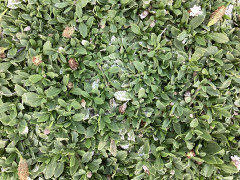
It seems to be doing a little better now. Has anyone else seen this problem?
john nazareno
8 months agoperhaps you're watering too much after 9 months if watered properly should have long deep roots already, try to see if you could get away w/o watering for a month. I have this problem during winter when there's too much moisture but goes away when weather start to dry up and I water only very slightly (10 gallons every 350 sq ft every month if they're lucky)
CHERYL V
8 months agolast modified: 8 months agoI'm in OC, California Our Kurapia was planted in May has been filling in well in most areas for the last 3 months but I still have bald spots. Currently battling major weeds and nutgrass and other grasses. I weed when I can when it starts to cool down but have a hard time because I am being eaten alive by mosquitos while I'm weeding ( I put on insect repellent early in the day) and there are more weeds than I can pull in a 2+ hour period. The weeds and grasses are so interwoven it's a challenge to minimize pulling Kurapia with the weeds. Are there any herbicides or weed and feed products that I can safely use. Am also battling clover,grasses and a myriad of weeds in the adjoining mulched areas. I use vinegar mixture with some success in those areas but barely making a dent. The tropical storm rain helped the Kurapia but the weeds and grasses too. Also John gave me some good tips about soaking the Kurapia once a week to get the roots going deeper and that helped revive some dead looking Kurapia but these weeds are relentless.

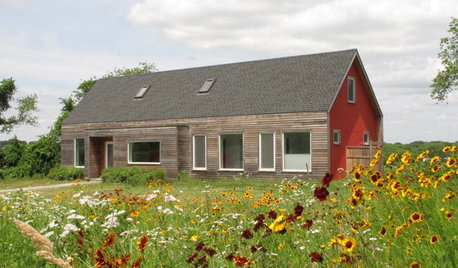
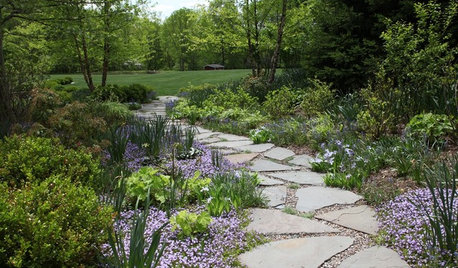
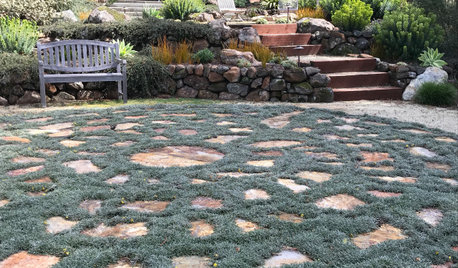







gthomson910 - Zone 10a/9b - Corona, Ca, US